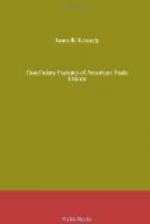[Footnote 94: Iron Molders’ Journal, March, 1871.]
[Footnote 95: Constitution, 1877 (Rockland, 1877), Arts. 1-2.]
[Footnote 96: Iron Molders’ Journal, Vol. 26, May, 1890, p. 2.]
[Footnote 97: Constitution, 1884 (Quincy, n.d.), p. 11 ff.]
Thus, both the death benefit and the insurance systems in American trade unions had their origin in the movement for mutual insurance which was so widespread in the United States immediately after the Civil War. Only in the railway brotherhoods did the plan result in any considerable increase in membership. In the other unions the insurance systems were replaced by the establishment of benefits, and these were usually smaller in amount than the insurance systems had contemplated.[98]
[Footnote 98: The death benefits established by the Cigar Makers and Iron Molders in 1870 and 1879 were for $40 and $100. The ordinary death benefit in American trade unions is still a sum assumed to be sufficient to inter decently the deceased.]
The tendency in those unions which have longest maintained the death benefit has been to increase the amount of the benefit and to grade the amount according to the length of membership. The policy of the unions in these respects has, however, varied considerably. In some cases there has been an increase in the minimum amount paid, together with provision for the payment of larger sums to members who have been longer in good standing. In other unions, such as the Iron Molders and the Pattern Makers, the regular benefit remains as originally established, but a larger sum is paid to older members. Only a few of the older organizations retain the uniform benefit. The most notable of these are the Typographical Union, the Glass Bottle Blowers, and the Hatters.
The grading of the death benefit serves two purposes. In the first place, the funds are protected. If the benefit were uniform and large, persons in bad health would be tempted to join the union in order to secure protection for their families. The grading of the benefit is accordingly a crude but fairly effective device against a danger which presents itself as soon as the amount becomes large enough to be attractive to “bad risks.” A more important reason, perhaps, for the grading of the benefit is the desire to make it a more effective agency in attracting and holding members. If continuous membership carries with it constantly increasing insurance, the lapses in membership lessen.
The maximum death benefits paid by the Cigar Makers and the Glass Bottle Blowers are $550 and $500, respectively. The Iron Molders pay a maximum benefit of $200; the Carpenters of $200; the Pattern Makers of $400; the Germania Typographia of $200. In all these cases except that of the Glass Bottle Blowers the benefit is graded according to the period of membership. The maximum benefit is paid in the Cigar Makers and in the Pattern Makers to members of fifteen years’ standing.




